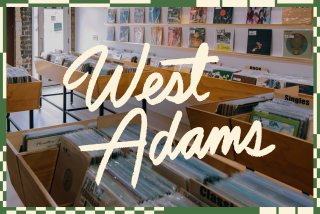Whomp, Giggle, Whee--Oh, No!
- Share via
Riding down Arlington Avenue isn’t as fun as it used to be. The decline just south of Adams Boulevard is smooth, but it doesn’t tickle anymore. It did when I was a kid.
My two brothers, sister and I chanted in the back seat of the red AMC Rambler like those movie kids banging their spoons for more food at a long wood table. “Make it tickle! Make it tickle!” Mom complied, going out of her way to include Arlington in our trips around the city.
As we crossed Adams Boulevard, our faces became brown versions of yellow smileys. We sat very still, because one time my brother, Kris, moved and didn’t “feel it.” Just as we crested the hill, the nose of the car dipped, and there it was, not 20 feet away. The Tickle. Mom, a pro at making it tickle by now, accelerated slightly . . . and then WHOMP! The Tickle. And WHOMP again!
Those were pre-seat-belt-law days, and like so many crash-test dummies, our heads bobbed as laughter ricocheted off the car’s roof, green-tinted windshield and vinyl seats. We were all cheeks, teeth, tongue, breath and diaphragm. Pure bliss.
The long-promised trip to Disneyland could wait another week.
The Tickle was a camel-backed decline of blacktop southbound (and an incline heading north) on Arlington just below Adams Boulevard. This “hump in the hill,” as one municipal worker termed it, was an integral topographic feature in the Los Angeles of my youth.
Having attended seven elementary schools, and having watched four of my childhood homes demolished, including one for what is now the Century Freeway, The Tickle was one of the constants. And after returning from 10 years in Washington, a place where the historic value of almost everything is debated, I was glad to see that The Tickle remained.
Magical how a simple 15 mph whomp over that geographic refrain could reawaken childhood memories and transport me into the back seat of that soon-to-be-repossessed red Rambler, into the company of giggling knuckleheads whose only care was a sensation in the pit of their stomachs, a moment when they could all agree on what they felt.
Arlington was the main stretch of my daily drive from Leimert Park to the American Film Institute in Los Feliz, where I worked. That is, until a bank of five blinking, yellow greater-than/less-than symbols detoured me east onto the 10 Freeway. Pausing to look beyond the gang of street maintenance signs and Tonka-like work trucks, I could see just to Adams. An accident or crime scene, I surmised. Someone murdered, maybe. The impatient flash of headlights behind urged me onward. I was sure the block would be clear on the way home.
It was blocked for the rest of the week.
Driving with a friend that Saturday, having forgotten about the construction, I took Arlington north. At the foot of the hill, along 27th Street, were barricades. I couldn’t believe my eyes. “It looks like The Tickle is gone,” I said as we approached.
“No, those bastards wouldn’t take out The Tickle!” my friend said. I was amazed that he knew what I meant by The Tickle.
We got out to see. Sure enough, The Tickle had been packed with earth. I could almost hear childhood laughter, muffled, buried somewhere beneath the dirt trucked in from some distant place. It felt like a loved one had undergone surgery and would never be the same. It was as sad as the day that our beautiful white mansion, now a ghost looking over this scene, was demolished. The Tickle never had a chance, I thought, remembering the human chains that were unable to save the magnificent work of a famous architect, a house rumored to have been a former home of Bette Davis.
The unanimity of people’s response to the smoothing over of this geographic feature was telling. My sister, Kim, wondered aloud which city official’s coffee had spilled as he drove the hill. An anonymous Internet chat buddy also remembered and bemoaned the loss; the “double-dip,” he called it.
Now I try to tell my young niece, D’Aundra, what was there, just beyond Adams. I try to describe the feeling in the pit of the stomach. She listens, bobbing her head, but will never know it. And so our connection is even more tenuous, further frayed by the memory of what is no more. Perhaps she and her own nieces and nephews will marvel at the smooth glide downward.
More to Read
Sign up for The Wild
We’ll help you find the best places to hike, bike and run, as well as the perfect silent spots for meditation and yoga.
You may occasionally receive promotional content from the Los Angeles Times.






